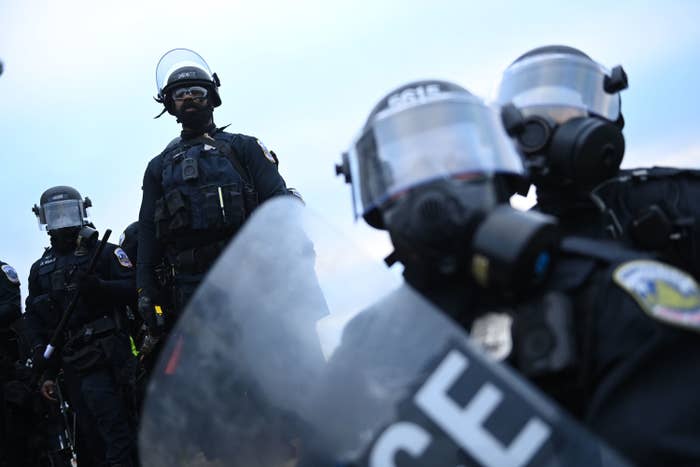
WASHINGTON — Seven US Capitol Police officers on Thursday filed the latest lawsuit seeking to hold former president Donald Trump responsible for the Jan. 6 insurrection — and shared their own accounts of the racial slurs, assaults, and emotional trauma they experienced that day.
Trump is already facing civil claims from members of Congress and other Capitol Police officers who responded to the riots. The new case, filed in federal district court in Washington, accuses Trump of conspiring with a host of actors with ties to the insurrection and the events leading up to it: longtime Trump ally Roger Stone; organizers of the “Stop the Steal” rally that preceded the attack; various right-wing groups, including the Oath Keepers, Proud Boys, and the Three Percenters; and individuals facing charges for their alleged criminal activities at the Capitol.
The complaint threads together public accounts of what Trump, Stone, and “Stop the Steal” organizers said and did before Jan. 6 with evidence culled from the hundreds of criminal cases filed to date documenting the specific movements of rioters. It’s the latest case to accuse Trump of violating the Ku Klux Klan Act, a federal law that prohibits conspiracies to violate civil rights, among other things.
“Defendants directed, incited, aided, and abetted attackers to break through police lines, to overwhelm and assault Plaintiffs and their fellow police officers, and to put Plaintiffs and their fellow police officers in reasonable fear for their lives,” lawyers for the Capitol Police officers wrote. “Many Defendants and co-conspirators participated in the Attack. Defendants all failed and neglected to take action to prevent or aid in preventing the violence that caused Plaintiffs’ injuries.”
Near the end of the document, the complaint described what the seven plaintiffs encountered on the ground. The stories they detail in the suit add to the growing collection of firsthand accounts from law enforcement officers who have come forward to publicly share the violence and harassment they faced from the hundreds of Trump supporters who descended on the Capitol:
Officer Conrad Smith
Smith worked to block off the doors to the House chamber and evacuate members as rioters breached the building. After being exposed to chemical irritants during the attack — pepper spray, bear spray, and fire extinguisher spray — he went back to guard the chamber that evening after rioters were cleared from the building and members could resume the official counting of the Electoral College vote. He’d been at his post since 7 a.m.
Sgt. Danny McElroy
McElroy’s shift at the Capitol had ended at 6 a.m.; he’d been on duty since 10 p.m. on Jan. 5. But as the riots unfolded midday, “he rushed back.” He was exposed to mace and bear spray at various locations. At one point, he took a rioter wearing a tactical vest into custody. During a search, he found the person had a knife along with a radio and multiple phones; prosecutors have cited the presence of radios as evidence that some rioters planned for some kind of fight or confrontation.
Officer Byron Evans
Evans was inside the Senate chamber and was locked in with the senators gathered there as rioters spread through the Capitol. He helped evacuate senators and guarded them, and he also went back to his post once the rioters were out of the building. He, too, was exposed to a variety of chemical sprays.
Officer Governor Latson
Latson is one of five plaintiffs who are Black, and he said that rioters who shoved him as they fought their way into a third-floor entrance to the Senate chamber called him the n-word. He went back to his post later in the day as well and was exposed to the same collection of chemical sprays that his colleagues faced.
Officer Melissa Marshall
Marshall was on the Capitol grounds trying to secure the perimeter around the building against thousands of people who had gathered outside. She evacuated workers who had been building a stage in anticipation of President Joe Biden’s inauguration festivities and tried to hide their tools so that rioters couldn’t use them as weapons against the officers. The officers she was with were “overwhelmed” by the rioters, and she helped bring inside a colleague with a head injury. While inside, she was assaulted as well as exposed to irritants.
Officer Michael Fortune
Fortune, who is Black, was also called the n-word by rioters as he made his way through the crowd in the afternoon to report for duty and was exposed to chemical sprays. He was part of the final push to clear rioters out of the building and saw the “chemical fog in the air, tables flipped, statues defaced, feces on the walls, and blood and broken glass on the floors.” He was also involved in searching for any hidden explosives left in the Capitol and helping injured officers get medical assistance. He arrived at 4 p.m. and didn’t leave until between 8 a.m. and 9 a.m. the next day.
Officer Jason DeRoche
DeRoche was positioned on the Capitol grounds outside and also helped evacuate construction workers. Rioters threw batteries at the officers he was with and deployed bear spray and mace at them; DeRoche was hit with spray. His eye swelled shut, and he also hurt his arm. He was exposed to more irritants in the air after he’d rinsed his eye out and went to another location. He stayed on duty until 11:30 p.m.

